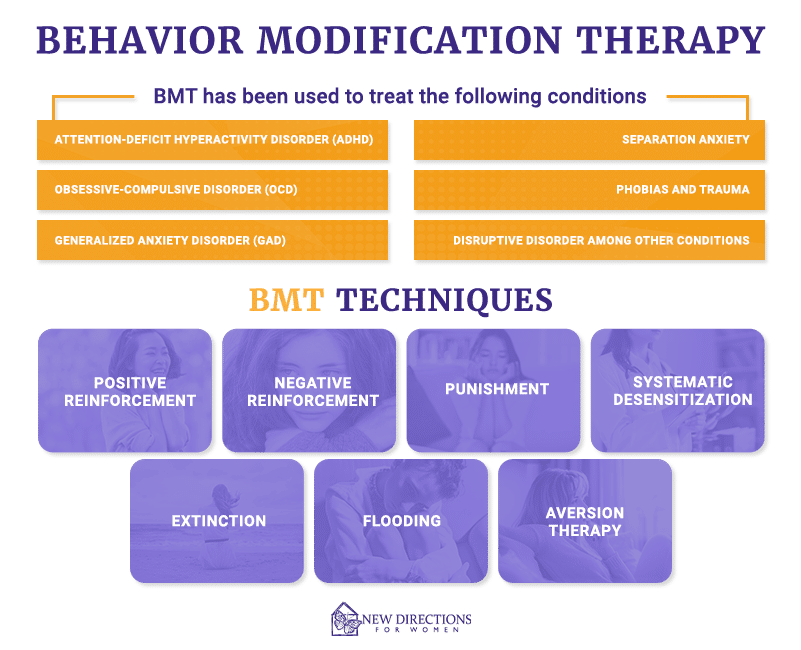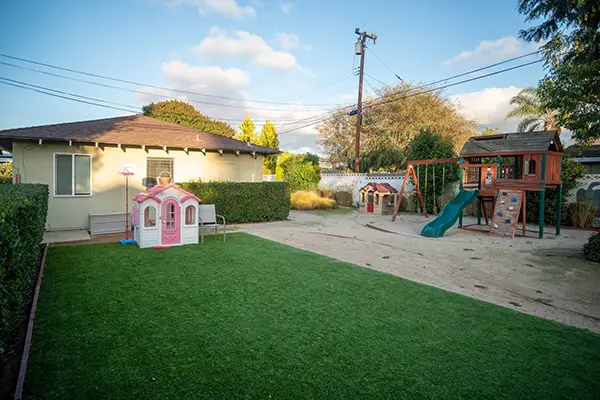Behavior modification therapy (BMT) is an approach designed to change (modify) a certain unwanted negative behavior. Using a system of positive or negative consequences, the individual learns the correct set of responses for any given event. This practice has several spinoffs that attempt to alter behavior through various actions and has developed throughout the years.
Parents use behavior modification to teach their children right from wrong. Animal trainers use it to teach and encourage obedience between an owner and their pet. Therapists also use it to promote healthy behaviors in their patients.

What Is Behavior Modification Therapy Used For?
Behavior modification has been proved to be successful in treating:
- attention-deficit hyperactivity disorder (ADHD),
- obsessive-compulsive disorder (OCD),
- phobias,
- separation anxiety,
- generalized anxiety disorder (GAD),
- autism, and
- disruptive disorder among other conditions.
How Does Behavior Modification Work?
Behavior modifications depend on the idea of conditioning, which is a form of learning. There are two major types of conditioning:
Classical Conditioning
Classical conditioning depends on a particular stimulus or signal. Here’s an example: If a family member came to the kitchen every time you baked cookies because of the delicious aroma.
Operant Conditioning
This involves using a system of rewards or punishments. Dog trainers use this method often when they reward a dog with a special treat after they obey a command. Likewise, if you reward your family member with a cookie every time they come to the kitchen, that will be a learned behavior. If you smack their fingers with a spatula when they come in, they will unlearn that behavior.
These theories are the basis for behavior modification because they support the idea that because behaviors can be learned, they can be unlearned. As a result of this, many distinct techniques were developed to either help in bringing about behavior or stopping it. This is how behavior modification was formed.
How Did Behavior Modification Therapy Develop?

In 1911, psychologist Edward Thorndike shaped the general theory of behavior modification through his Law of Effect. The Law of Effect concludes that certain actions in a situation are made as a result of the possible available consequences. For instance: The probability of you touching a hot stove burner voluntarily is going to decrease based on the consequence that the burner is hot and you’d burn your hand.
Behavior modification built on Thorndike’s Law of Effect and developed from B.F. Skinner’s theory of “operant conditioning.” It aims to change or shape behavior through a set of incentives and response actions. Operant conditioning works under the assertion that the best way to understand a person’s behavior is to look for the reason for the action and the results of that action. Behavior modification is common in schools, at home, and in substance use treatment settings.
Skinner believed that there were three types of responses:
- Neutral: Responses that are not positive or negative.
- Reinforcing: Considered to be positive.
- Punishing: Considered to be negative.
Behavior Modification Techniques
The purpose of behavior modification is not to understand how or why a certain behavior started. The focus is only on changing the behavior, and there are different methods used to do that. These methods include:
Positive Reinforcement
Associating a positive stimulus to a behavior. An example of this is when teachers reward students for good grades with stickers. This technique is often used in training dogs.
Negative Reinforcement
This is just the opposite of positive reinforcement and is the pairing of behavior to the removal of a negative stimulus. An example might be when a child throws a tantrum because he doesn’t want to eat vegetables. And then the vegetables are taken away, reinforcing the negative behavior.
Punishment
Punishment is meant to weaken behaviors by pairing an unpleasant stimulus to a behavior. Receiving a pay cut for calling off work is an example of punishment.
Flooding
Flooding involves exposing people to fear-producing situations or objects intensely and rapidly. An example would be forcing someone with a fear of snakes to hold one for 10 minutes.
Systematic Desensitization
This is also used to treat phobias. It involves teaching an individual to stay calm while focusing on their fears. An example would be having a person with an intense fear of bridges start by looking at pictures of bridges. Then have them think about standing on a bridge and eventually, have them walk over a real bridge.
Aversion Therapy
Aversion therapy is the association of an unpleasant stimulus to an unwanted behavior for the purpose of eliminating that behavior. As an example, some people bite their nails. In order to stop this behavior, you can paint a substance on the nails that has a horrible taste. Thus, it stops the behavior of nail-biting.
Extinction
Extinction is the removal of all reinforcement that might be associated with a behavior. An example would be a time-out when a child is removed from others when they misbehave. This method removes the expected reward of attention from the parents.
Treating Substance Use Disorder (SUD) with Behavior Modification Therapy
When an individual is struggling with drug dependency, it’s easy to focus on everything the person is doing wrong and react with punishment, lectures, and confrontation. However, this often only intensifies the tension.
Behavior modification therapists teach basic skills to individuals suffering from SUD. Through this type of treatment, they learn self-awareness through establishing new, healthier behaviors.
Measuring Success of BMT
BMT is considered to be an effective type of therapy for people suffering from a variety of disorders. Because of the diagnostic principles of behavior and reinforcement, the progress of individuals with SUD can be easily observed and documented by the therapist. On the other hand, in psychotherapy (talk therapy) or drug therapy, clear goals with understandable treatment schedules are developed and fulfilled bit-by-bit during the course of treatment.
Still, BMT is usually used as part of a multi-therapy approach that includes drug therapy and psychotherapy which only contributes to the effectiveness of these therapies. BMT participants have remarkably high success rates after going through therapy as illustrated:
- Obsessive-Compulsive Disorder: Success rates as high as 80% have been recorded in adults who undergo an intensive BMT treatment plan.
- Generalized Anxiety Disorder: Behavioral therapy is an important element of treating the disabling anxiety suffered by people with GAD. Studies have shown that BMT can bring about positive change in a large number of individuals.
- Addiction: Treatment of addiction requires attention to detail, constancy, and continual evaluation, which makes it suited for BMT. Behavioral therapy is recognized as one of the most effective parts of addiction treatment. In addition to changing addictive behaviors, it also helps to concentrate on underlying issues that contribute to addiction, such as depression and anxiety.
Applied Behavior Analysts Treat Addictions as Trainable Behavior
Drug addiction is one of the most expensive and disruptive health issues in the U.S. these days. According to the National Institutes of Health, alcohol, drug, and tobacco use costs the country more than $500 billion in medical and related expenses each year. Although the precise causes for addiction are not easily understood, it is generally agreed that it comes from a combination of genetic and environmental factors.
According to a report from the National Council on Drug Abuse, applied behavior therapies for addiction started with treatments for smoking and obesity. The early results were encouraging and as highly addictive drugs such as heroin, cocaine, and methamphetamines rose in popularity, behavioral treatments became one of the most effective tools to address the problem.
Commonly Used Behavioral Therapies in Addiction Treatment
Contingency Management (CM)
CM is the most commonly used technique in addiction treatment. Contingency management encourages behavior modification by providing material rewards for a target behavior, like clean drug tests, attending meetings, etc. Individuals receive a reward such as money, vouchers, gift certificates, clinic privileges, or other healthy premiums.
Research has shown that CM treatment can be effective in the increase in treatment recall and abstinence from drug use. The National Institute on Drug Abuse (NIDA) considers contingency management interventions an evidence-based approach for treating a variety of SUDs.
Cognitive Behavioral Therapy (CBT)
CBT was originally designed for the treatment of depression, and it is effective in treating multiple types of SUDs. CBT teaches people to recognize problem behaviors and triggers for harmful drug or alcohol use and to develop strategies to cope with these situations and environments. Research shows that the effects of CBT continue long after therapy sessions are complete. NIDA considers CBT an evidence-based method for treating a range of SUDs.
Motivational Interviewing (MI)
MI is a style of counseling that is especially helpful for focusing on indecision toward unhealthy behaviors. MI is an evidence-based treatment that builds an individual’s confidence in their ability to successfully make a change. By doing that, it helps people with SUD examine their desire for change and begin the process of making that change. It is designed as a brief treatment and therefore could be beneficial for people who don’t have long-term access to treatment specialists.
Family Therapy
Family therapy targets the strength and assets of the family to address substance use and reduce the effect of the disorder on the individual and the family. Two commonly used models are:
Family Behavior Therapy (FBT)
FBT is different from other therapies because it involves not just the user but includes a family member or significant other of the user. It includes communication skills training and training on resisting urges among other interventions. FBT has shown positive outcomes in both adults and adolescents. Besides treating SUD, it also focuses on co-occurring issues like child mistreatment, depression, conduct disorders, and family conflict.
Behavioral Couples Therapy (BCT)
During BCT, therapists work with the individual who has an SUD and their spouse or partner. Spouses and partners are included in SUD treatment to give support with abstinence and to help prevent relapse. Couples attend therapy sessions together during which they develop a recovery contract, complete homework assignments, and learn effective communication tools. BCT has shown to lead to increased abstinence and improved relationships when compared to individual-based treatments.
Why is Behavioral Modification Therapy Important for Women?
Women face many issues throughout their lives. While each woman is different, struggling with different issues, some of the most common issues include:
- Depression: More than just feeling sad, depression is a chronic illness that can disturb a woman for a particular period or go on her entire life.
- Anxiety: Everyone feels anxious occasionally. Whether it’s worrying about a social situation or feeling nervous about public speaking. For most people these feelings are normal. But for other people, an anxiety disorder can be disabling. Women who suffer from anxiety disorders spend much of their days in stress and panic.
- Bipolar Disorder: A mood disorder caused by the brain, bipolar disorder can begin suddenly or develop slowly. It is characterized by severe mood swings.
- Post-Traumatic Stress Disorder (PTSD): Although a person of any gender can experience sexual abuse, women are, by far, most commonly victimized and they often blame themselves. In addition, domestic violence can take place in childhood or in the woman’s current situation. When a woman is abused, she may feel worthless, depressed, isolated or anxious.
Women and Substance Use Disorder
Scientists who study SUDs have found that women who use drugs can have problems related to hormones, menstrual cycle, and menopause. And women themselves have described individual reasons for using drugs, including:
- Controlling weight
- Coping with pain
- Dealing with exhaustion
- Self-treating mental health conditions
Scientists also found that:
- Women often use smaller amounts of certain drugs for less time before they become addicted.
- Women tend to have more drug cravings and are more likely to relapse after treatment.
- Women who are victims of domestic violence are at increased risk of using substances.
- Divorce, death of a partner, or loss of child custody can trigger a woman’s drug use or other mental health disorders.
Behavior modification therapies have been proved to be effective and recommended by NIDA and the Substance Abuse and Mental Health Services Administration (SAMHSA) as evidence-based treatments for treatment of substance use and co-occurring mental health disorders.
A New Direction for Women
It can be difficult for anyone with a SUD to quit. However, women may be afraid to get help due to possible legal or social fears and lack of child care while in treatment. Women in treatment frequently need more support for handling the responsibilities of work, home care, child care, and other family obligations.
At New Directions for Women, we understand your issues. That’s because we treat only women. We have treatment programs from detox to aftercare, with four levels of care in between. Our trained professionals are experienced in behavioral therapies as well as holistic and family therapy. Contact us now. Ask about our family and children services as well as our program for pregnant women if it applies to you. We care about you and your family. Don’t wait. You already know it won’t get better on its own.



